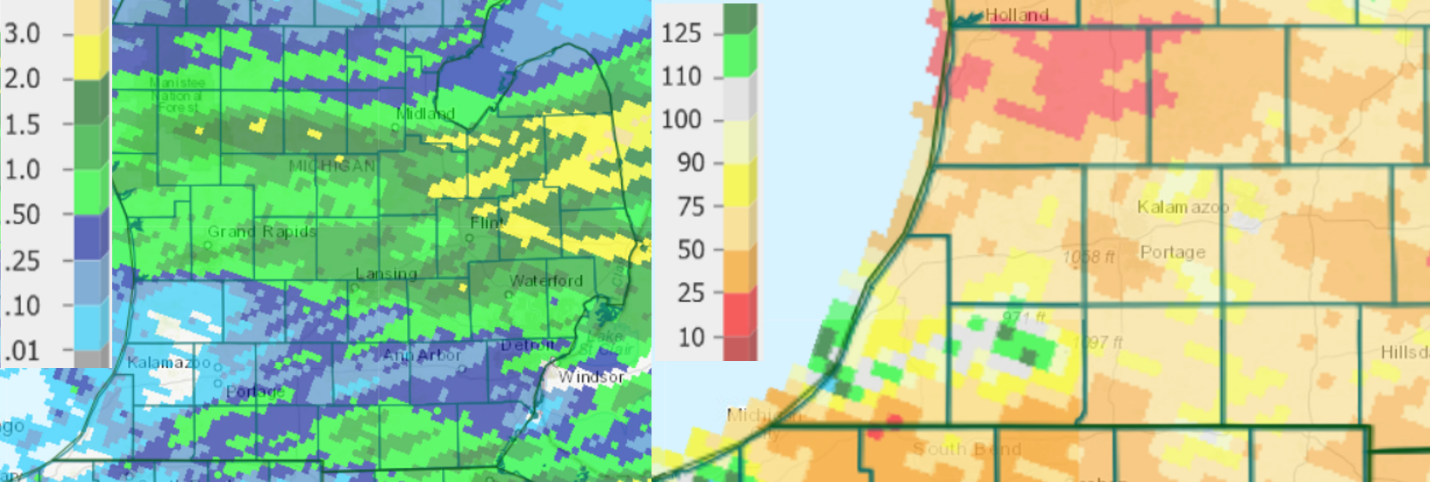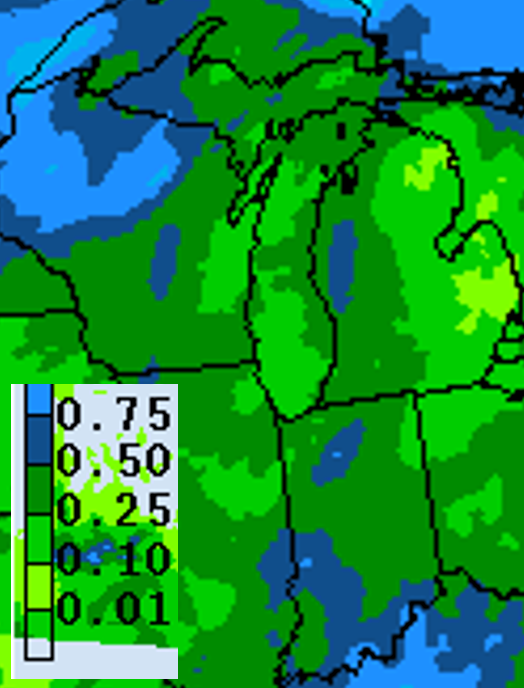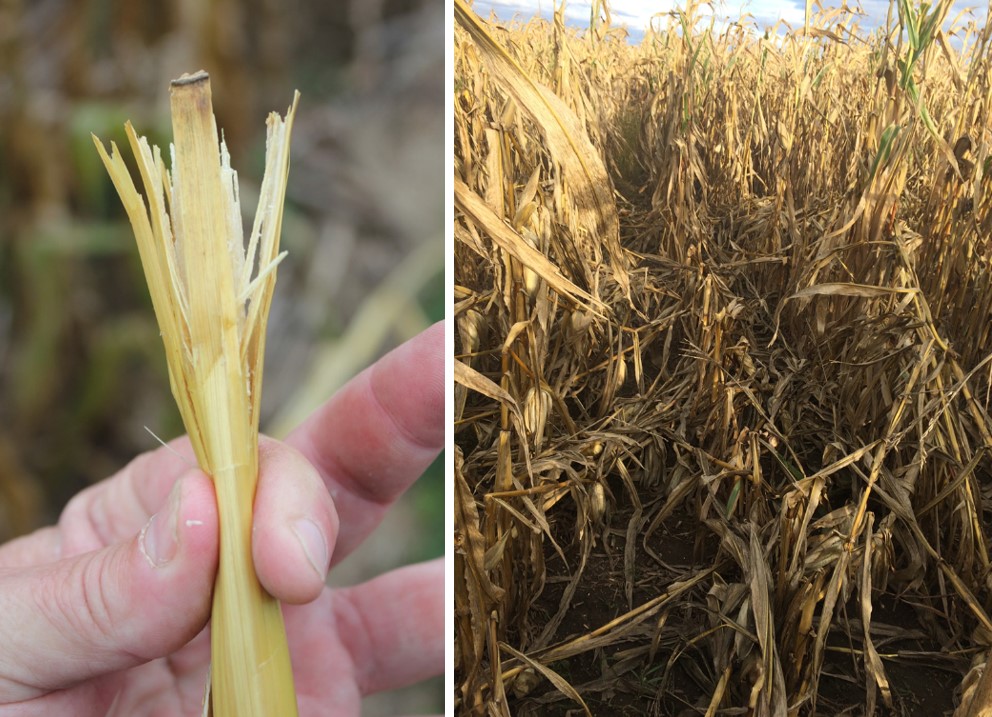Southwest Michigan field crops update – Sept. 16, 2021
Warm and dry conditions continue to aid in grain dry-down and push later planted fields toward maturity. Corn and soybean harvest has begun in early planted and early maturity fields.

Weather
Temperatures this past week were 3-5 degrees above normal, which only served to add to our growing degree day surplus to 200-300 and hasten crop development in later-planted fields and grain dry-down. The forecasts for the next two weeks call for continued warmer-than-normal temperatures with a slight reprieve later in the week next week followed by a return to high temperatures. The long-lead outlook for the fall is also calling for warmer-than-normal conditions as a mild to moderate La Niña develops heading into winter.
Precipitation this past week was very light across the region with totals ranging from no rain to nearly an inch this past Tuesday. The main story in the state was in the central region where severe storms came through dropping 1-3 inches of rain with isolated areas of very high winds and reports of hail as big as 2.5 inches. Overall, this past month has been relatively dry for our region with 1-3 inches of rain less than average. There is a slight chance of a small amount of rain this Friday into Saturday, but the next good chance of significant rain comes toward the middle of next week.
The 6-10 day outlook calls for a slight chance of above-normal rainfall while the 8-14 day outlook predicts below-normal. Michigan State University Extension agriculture climatologist Jeff Andresen says he would have made the predictions normal to below-normal for this time period, but the models have a low level of confidence at this point.



Crops and pests
Corn in many fields in the region has reached physiological maturity (R6, or black layer) and harvest of early planted and early maturity fields has begun. Though early, one report of yields well below those previously estimated came in with the suspicion that tar spot was a major factor in reducing grain fill. Test weights of 50-52 pounds per bushel have been reported. This is likely due to a combination of dry conditions in some areas during grain fill and the effects of diseases such as tar spot.
In portions of Van Buren and southern Allegan counties where heavy rainfall fell during two events in mid- and late June, flooding damaged corn significantly on heavier soils, reducing yield potential by 50% on more in inundated fields. Portions of southwest Michigan’s corn and soybean production will surely not celebrate record yields this season.
Some fields appear to have completely senesced (turned brown) before black layer is reached. Bob Nielsen, Purdue University’s corn agronomist emeritus, says that corn grain can dry down under these conditions with percent moisture into the low 20s before black layer. In those cases where the plant has completely lost all photosynthetic capacity, the black layer can still form but it will take time, depending on how far along the crop was prior to total death. He warns that early harvest when the ears are still rubbery will likely result in increased kernel breakage (foreign matter) and in greater harvest losses with more volunteers in the field next year.
Another bit of “cheery news” in these heavily tar spot impacted fields is that stalk strength is likely to be somewhat compromised. This stems from the fact that the corn plant will scavenge carbohydrates from the stalks during the later grain fill stages to try to produce larger kernels. While this is good from the standpoint of test weight improvement, it can cause a significant challenge in keeping stalks upright. We encourage folks to keep an eye on stalk strength in fields that had significant tar spot during the R5 or earlier growth stages. While this does not always mean stalk strength declines, it certainly has caused that in hybrids that are especially sensitive to the disease over the past few years.
We suggest conducting “push tests” on stalks periodically to gauge the strength of the stalks, prioritizing fields where the plants lodge the easiest. We typically suggest pushing the plants at around the ear level to about 30 degrees (8-10) inches at this height and see how many topple over due to weak stalks. More than 10-15% stalks that lodge should be placed at the top of the priority list for early harvest. Do this periodically throughout the harvest season to determine the likelihood of lodging and to re-prioritize your harvest order.
In fields that are really at risk, you can sometimes lodge corn by crushing the stalk between your thumb and forefinger. The video below shows how weak a heavily infected tar spot field was in 2020 near the Paw Paw, Michigan, area in mid-October.
Soybean harvest has also begun in early-planted and early maturity group varieties. MSU Extension soybean educator Mike Staton says reports of lodging have been coming in—nothing severe, but prevalent enough in those fields to make harvest potentially challenging.
Soybean cyst nematode was the topic of this week’s MSU Extension Field Crops Virtual Breakfast with nematode specialist Marisol Quintanilla. As soybean cyst nematode is the #1 yield robbing pathogen in soybean in North America, it is important farmers utilize best management practices to minimize losses. These include rotating sources of resistance, including non-host crops (almost any crop other than soybean) in the rotation, cleaning equipment (tires, tillage implements) between fields, and using nematode-protectant seed treatments. Coarse-textured soils, fields with high pH, and dry soils can all exacerbate soybean cyst nematode problems.
Quintanilla shared the results of her lab’s research on the impacts of various cover crops and manure types on soybean cyst nematode numbers. She said at least two companies are working toward releasing soybean varieties with a new source of resistance, and one webinar attendee shared that a variety is currently being offered with a source of resistance other than PI88788 and Peking.
If you were not able to join the session, the recordings will be closed-captioned and available at the Field Crops Virtual Breakfast webpage and the MSU Extension Field Crops Team social media platforms: Facebook, Spotify, YouTube, Apple Podcasts and Twitter.
Irrigation
A few irrigated late planted or second planting soybean fields will still benefit from irrigation, but needs are low. Forecasted reference evapotranspiration (FRET) rates are 0.9-1.0 inch in the coming week. Crop coefficients (Kc) for corn and soybean in the last two weeks before maturity are 0.60 and 0.75 for corn and soybean, respectively, and forages will be 1.0. Irrigating up cover crops 0.4-0.6 inch may also save your cover crop investment.
September is historically the low price month for irrigation equipment purchases. However, irrigation equipment prices are up 23-28% since fall of 2019, so it will be particularly important for producers to make good financial decisions that fit the family’s future. Investigate market opportunities for higher-value crops such as seed production, contract feeds, high-value hay, vegetables and ornamentals to make the most of your irrigation investment.
Underground pipe, wire and fittings are in short supply and high demand. Well drillers, excavators and electric installations people are booked out into winter already. Getting a complete plan in place and getting your name on the lists are important.
More information and tools are available at the MSU Extension Irrigation website.



 Print
Print Email
Email





